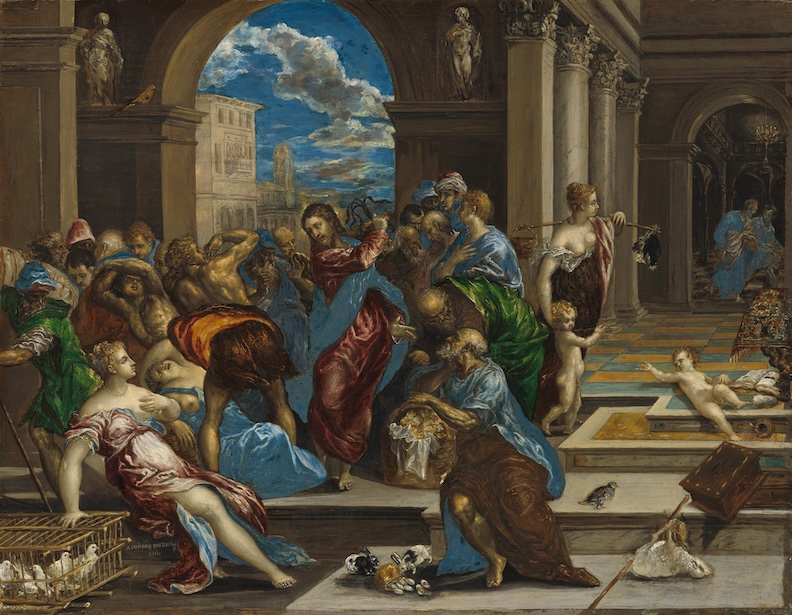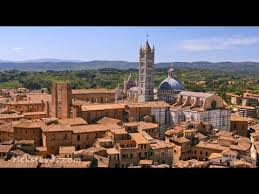All four Gospels tell of Jesus cleansing the temple. The Gospel of John, however, provides the most detail about what took place, which bears witness that the Evangelist was present at this event. (John 2:13-22) Jesus went to Jerusalem to celebrate the Passover, the feast that commemorated both the Israelites’ passing out of slavery in Egypt and the covenant that God made with the Jewish people in the wilderness.
“In the temple he found those who were selling oxen and sheep and pigeons, and the money-changers at their business.” The scene that Jesus beheld was that of exploiting the temple and its sacrifices for monetary gain. Upon observing such roguish activity, Jesus made a whip of cords and drove them all out, even violently scattering the coins and turning over the tables. He told those selling pigeons: “Take these things away; you shall not make my Father’s house a house of trade.”
By referring to the temple as “my Father’s house,” Jesus reveals that he is the Father’s Son. Being the Father’s incarnate Son, Jesus, then, is the custodian of his Father’s house – the temple where his Father dwells. His very singular distinctiveness as the Father’s incarnate Son gives him unparalleled authority over his Father’s house, and so the right to cleanse the temple from all that is ungodly. The disciples later remembered the scripture passage: “Zeal for your house will consume me.” (Psalm 69:9). Jesus has fulfilled that oracle.
In response to Jesus’ actions, the stunned and irate Jews, nonetheless, demand a sign that would authenticate his authority for performing such an unprecedented action, to which Jesus responds: “Destroy this temple, and in three days I will raise it up.” The Jews immediately note that the temple has taken forty-six years to build, and “will you raise it up in three days?”
The word “this” is theologically significant. On the one hand, “this” is the stone temple that is directly in front of them. On the other hand, as the Evangelist later grasps, Jesus was referring to himself. “But he spoke of the temple of his body. When, therefore, he was raised from the dead, his disciples remembered that he had said this, and they believed the Scripture and the word which Jesus had spoken.”
As the Son of God incarnate, Jesus is the new and living temple, “for in him the whole fullness of deity dwells bodily.” (Colossians 2:9) To come into God’s presence, one no longer needs to make a pilgrimage to Jerusalem and enter the temple. Rather, Jesus is the Word made flesh, and, therefore, God now tabernacles among humankind.
Jesus is “the Father’s house” in which his Son now abides. To be in communion with the Father, one must abide in his incarnate Son. The temple is now superfluous. It was a prophetic anticipation of the Incarnation, and now, with the coming of Jesus, it has lost the purpose for which it was built.

Moreover, if Jesus, as the incarnate Son of God, is the new and living temple, he must now offer the perfect Passover sacrifice wherein he will establish a new and everlasting covenant. Likewise, through this new covenant, Jesus must cleanse the world of sin and cast out death, for only by being cleansed of sin with its curse of death can humankind pass over to a new life of holiness. This Jesus accomplishes in his sacrificial death and glorious resurrection.
The Jews do destroy Jesus, who is “this temple,” by crucifying him. But as the living temple, Jesus, through his crucifixion, becomes the perfect high priest who offers the perfect Passover sacrifice of the new covenant. That the Passover sacrifice of himself was efficacious is found in Jesus raising himself gloriously from the dead on the third day. In so doing, Jesus, as risen-incarnate-Son of the Father, now becomes the glorious heavenly temple, the Father’s new house, wherein all have access to his heavenly Father.
St. Peter beautifully states the relationship between Jesus as the risen temple and those who abide in him: “Come to him, to that living stone, rejected by men but in God’s sight chosen and precious; and like living stones be yourselves built into a spiritual house, to be a holy priesthood, to offer spiritual sacrifices acceptable to God through Jesus Christ.” (1 Peter 2:4-5)
The risen Jesus is the living stone that was discarded by men but selected by God as the cornerstone of the living and life-giving temple. Those who abide in the risen Jesus also become living stones in the Father’s new spiritual house, for they have become holy priests offering spiritual sacrifices in, through, and with the risen Christ Jesus.
As part of the destruction of Jerusalem, “this temple,” too, was destroyed by the Romans in 70 A.D., which was foretold by Jesus. His disciples pointed out to him the beauty of the temple. In response, he said: “You see all of these, do you not? Truly, I say to you, there will not be left here one stone upon another, that will not be thrown down.” (Matthew 24:1-2) And that happened.
It may have appeared to most that its destruction was a simple historical event that should be noted. It could no longer stand, however, for if it remained, it would be an opposing sign to “this temple” that is the risen Lord and Savior, Jesus Christ. Presently, its very absence remains a sign of the presence of the indestructible living temple.
John the Evangelist, in the Book of Revelation, has a vision of the heavenly Jerusalem. “And I saw no temple in the city, for its temple is the Lord God the Almighty and the Lamb.” (Revelation 21:22) In the heavenly Jerusalem, there is no need of a temple, for in Heaven one abides fully, in communion with the ever-living Lamb, in the Father’s house – a house that will never be destroyed.















